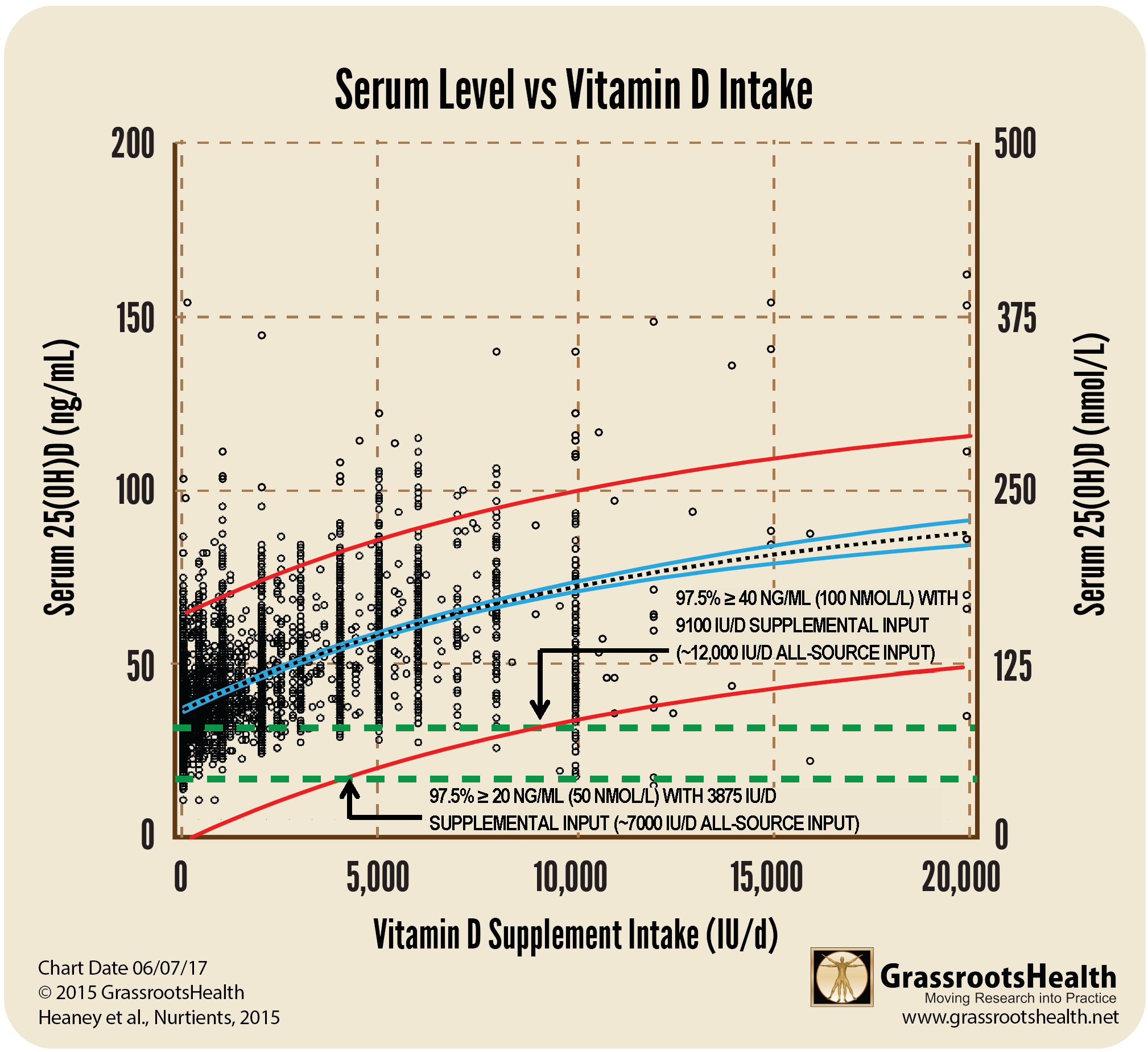Published on June 15, 2020
 Our vitamin D myth busting series continues with one of the most important-to-address myths about vitamin D – that the current recommended daily allowance (RDA) of 600 IU per day, from all sources, and recommended serum level of 20 ng/ml (according to the Institute of Medicine, or IOM), is enough… It is not! Unfortunately, this is what medical doctors are taught… We often hear from participants things like “My doctor told me all I need is 600 IU/day, and that it is dangerous to take more,” or “There is no benefit to taking more vitamin D or having a level above 20 ng/ml, because that is what the medical recommendation is.” We have even seen “Don’t exceed a vitamin D blood level of 39 ng/ml – it could be dangerous!” and “Be aware that people who are black generally have lower total vitamin D levels than whites, but new research suggests these lower levels may be sufficient for blacks,” both of which can be refuted simply by looking at natural vitamin D levels from hunter-gatherer tribes in Africa.
Our vitamin D myth busting series continues with one of the most important-to-address myths about vitamin D – that the current recommended daily allowance (RDA) of 600 IU per day, from all sources, and recommended serum level of 20 ng/ml (according to the Institute of Medicine, or IOM), is enough… It is not! Unfortunately, this is what medical doctors are taught… We often hear from participants things like “My doctor told me all I need is 600 IU/day, and that it is dangerous to take more,” or “There is no benefit to taking more vitamin D or having a level above 20 ng/ml, because that is what the medical recommendation is.” We have even seen “Don’t exceed a vitamin D blood level of 39 ng/ml – it could be dangerous!” and “Be aware that people who are black generally have lower total vitamin D levels than whites, but new research suggests these lower levels may be sufficient for blacks,” both of which can be refuted simply by looking at natural vitamin D levels from hunter-gatherer tribes in Africa.
Is it dangerous to take more than the RDA of vitamin D?
We have already addressed the idea that taking more than 600 IU of vitamin D per day may be dangerous – toxicity is very difficult to achieve, and most people need much more than 600 IU to even reach a vitamin D level of 20 ng/ml. Keep in mind there is a very small group of individuals with rare conditions, such as primary hyperparathyroidism, sarcoidosis, and other granulomatous disorders, who may need to be cautious with vitamin D intake.
Is it dangerous to have a vitamin D level of greater than 20 ng/ml? 39 ng/ml?
When our director, Carole Baggerly, founded GrassrootsHealth, she toured the country and spoke with vitamin D researchers and scientists, most of whom have been experts in the field doing vitamin D research for decades! Her goal in consulting them was to come up with a recommended range for a target vitamin D serum level that could achieve the best health outcomes for the majority of the population. The consensus reached was 40-60 ng/ml (100-150 nmol/L), and each and every one of our now 48 scientists on that panel agree that this level is not only safe, but also a desirable target for the benefit of multiple health outcomes.
What led to the confusion? The BIG mistake by the IOM
The Institute of Medicine (IOM, now the National Academy of Medicine) is tasked with determining dietary recommendations for the United States and Canada, and their findings often provide influence for medical institutions as well as recommendations in other countries. In 2010, the IOM updated their guidelines for vitamin D, with an RDA of vitamin D from all sources at 600 IU per day for ages up to 70 years old and 800 IU per day for ages 71 years and older. This determination was made based on their calculations that this requirement would be sufficient for 97.5% of the population to be able to achieve a vitamin D serum level of at least 20 ng/ml (50 nmol/L).
 First off, our focus at GrassrootsHealth, based on evidence and the consensus of experts, has always been that the target range for vitamin D should be 40-60 ng/ml; 20 ng/ml is simply not enough. It turns out that there’s another serious problem: a review of the IOM’s statistical methods shows that they were not correct – 600 IU/day will not get 97.5% of the population to 20 ng/ml. Instead it will only get 50% of the population to that level.
First off, our focus at GrassrootsHealth, based on evidence and the consensus of experts, has always been that the target range for vitamin D should be 40-60 ng/ml; 20 ng/ml is simply not enough. It turns out that there’s another serious problem: a review of the IOM’s statistical methods shows that they were not correct – 600 IU/day will not get 97.5% of the population to 20 ng/ml. Instead it will only get 50% of the population to that level.
A paper from Paul J. Veugelers, Ph.D. showed, through statistical analysis, using the same data the IOM chose to use to compute the RDA, that the correct analysis should have revealed an RDA closer to 8,895 IU/day.
Both Veugelers, using the IOM data set, and Dr. Robert Heaney, using a separate data set from GrassrootsHealth, came up with approximately the same result, demonstrating that we need roughly 10 times more than the current recommendation. This blog gives a detailed break-down of what the error was and how the correct analysis was done.
7,000 IU/day using GrassrootsHealth data
GrassrootsHealth and its scientist panel also disagreed with the RDA but went about a different way to show it. Instead of re-hashing the same data set, GrassrootsHealth used the D*action data set, which at the time had 3657 individuals taking between 0 and 10,000 IU/day. This was a sample with measured vitamin D levels and reported supplement dosages within the parameters of what was being recommended.
To address the question of how much vitamin D is needed to reach a specific serum level, GrassrootsHealth plotted each person’s result (their attained serum level and reported daily supplement intake) and created the 95% confidence bands, just as the others had done. The chart above shows that 97.5% confidence (lower red line) crosses 20 ng/ml (50 nmol/L) serum level at a supplementation intake of 3,875 IU/day supplementation. But, we also get vitamin D from our food and the sun. (The studies used by the IOM were conducted in the winter months in the northern latitudes so that sun exposure would not be an additional source of vitamin D.) From the answers in the D*action questionnaires published in a different GrassrootsHealth paper, we know most of our participants get approximately 3300 IU/day from food and the sun – so the total vitamin D intake for a day is roughly 7,000 IU/day.
Overall, 7,000 IU/day from all sources is only the amount needed to get 97.5% of the population to 20 ng/ml (50 nmol/L). A serum level of 20 ng/ml is only high enough to prevent rickets. GrassrootsHealth, with its panel of 48 vitamin D researchers, recommends a serum level of 40-60 ng/ml in order to prevent disease. Using the same data and extrapolation as above, it would take 12,000 IU/day, from all source inputs, to get 97.5% of the population to 40 ng/ml.
How should we use this information?
Many of us have people we are trying to teach about vitamin D. We encourage them to get their serum levels above 40 ng/ml – usually by adding supplemental intake of 4,000 IU/day or even up to 10,000 IU/day. We give them all the information and have them convinced. Most importantly we encourage them to measure their serum vitamin D level so they know where they stand.
The RDA affects how doctors react to vitamin D. With the RDA set at 600 IU/day, many practitioners are hesitant to recommend that their patients take any more than 1000 – 2000 IU/day, even when they have measured the serum level and found it to be low. At that level of intake, many people will never reach a healthy level of 40-60 ng/ml (100-150 nmol/L), nor are they likely to even reach the RDA goal of 20 ng/ml (50 nmol/L).
In upcoming posts, we will address the myth that it is easy to achieve the necessary vitamin D levels from food and sun alone. Stay tuned!
Is it True?
Our “Vitamin D Myths” series will continue to provide information and resources to answer the question, “Why should I care about vitamin D?” and to help dispel the myths and misconceptions surrounding it that may be preventing you and others from accepting it as an essential component to health. We will also discuss other nutrients essential to the function of vitamin D (and vice versa) within the body that should not be ignored.
Vitamin D is necessary for multiple functions within the body and should not be ignored, but has the hype about vitamin D and its role in the body’s response to COVID-19 been over-exaggerated? What concerns about vitamin D are valid, and which are not? We want to provide you with evidence-based information to help you decide what vitamin D action to take, if any, for your own health.
We want to hear from you!
Is there a particular ‘myth’ you have heard about vitamin D? Or, something you have read or been told that makes you question whether vitamin D ‘deserves’ so much attention? Or whether you should be taking it and how much? Share with us by emailing jen @grassrootshealth.org what you have heard that makes you question vitamin D so that we can consider addressing it in our newsletters.
Do You Have Enough Vitamin D to Support a Healthy Immune System?
Do you know what your vitamin D level is? Be sure to test today to find out, and take steps to keep it within a target of 40-60 ng/ml or 100-150 nmol/L! Give your immune system the nutrients it needs to support a healthy you and protect yourself from unnecessary diseases.
Through GrassrootsHealth Nutrient Research Institute, you can also test your essential elements magnesium, copper, zinc and selenium, toxins such as lead, mercury and cadmium, as well as your omega-3 levels, inflammation levels and thyroid stimulating hormone (TSH) level. Find out your levels today! Log on to the test selection page (click the link below) to get your tests and see for yourself if your levels can be improved.
Make sure you track your results before and after, about every 6 months!
How can I track my nutrient intake and levels over time?
To help you track your supplement use and nutrient levels, GrassrootsHealth has created the Personal Health Nutrient Decision System called
For each specific supplement, you can track what days you take it, how much, and many other details. This will help you know your true supplemental intake and what patterns of use work for you to reach and maintain optimum nutrient levels. Check it out today!








